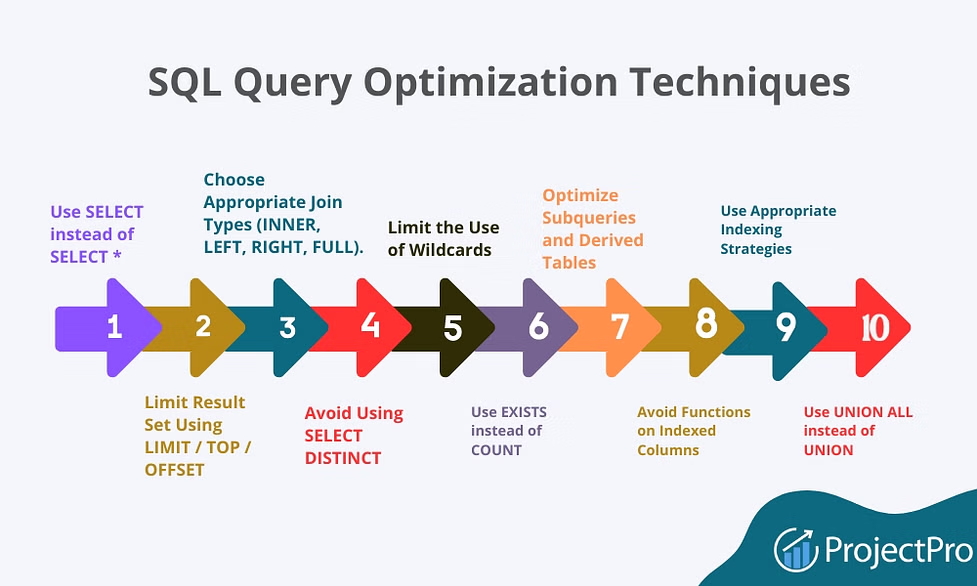Optimizing SQL Queries for Large-Scale Datasets
Learn advanced techniques to improve query performance and reduce execution time for massive datasets.
Introduction
Optimizing SQL queries for large-scale datasets is a critical skill for database engineers and backend developers working with enterprise-level systems that handle millions of transactions daily. In today's data-driven business environment, poorly written queries can lead to catastrophic consequences including slow response times that frustrate users, increased resource consumption that drives up operational costs, and even complete system outages that can cost organizations thousands of dollars per minute in lost revenue and damaged reputation. Modern enterprises generate and store massive amounts of data across multiple systems, from customer transactions and user interactions to sensor data and financial records, making query optimization not just a technical necessity but a fundamental business imperative that directly impacts competitiveness and profitability.
The complexity of modern database systems has grown exponentially with the advent of distributed architectures, cloud computing, and real-time analytics requirements. Database administrators and developers must now consider factors such as network latency, data partitioning strategies, concurrent user loads, and cross-platform compatibility when designing and optimizing queries. Furthermore, the increasing adoption of microservices architectures means that database queries often span multiple services and data sources, requiring sophisticated optimization techniques that go beyond traditional single-database approaches. Understanding these complexities and implementing effective optimization strategies has become essential for maintaining system performance and ensuring business continuity in an increasingly competitive marketplace.

Analyzing Execution Plans
The foundation of effective SQL optimization lies in understanding and analyzing query execution plans, which serve as detailed blueprints showing exactly how the database engine processes your queries step by step. Start by examining these execution plans using sophisticated tools like SQL Server Management Studio, Oracle Enterprise Manager, or EXPLAIN commands in PostgreSQL and MySQL, which provide comprehensive insights into the query processing workflow. Look specifically for performance bottlenecks such as full table scans that indicate missing or ineffective indexes, expensive join operations that consume excessive CPU and memory resources, and implicit data type conversions that force the engine to perform unnecessary computational work. These execution plans reveal not only the current performance characteristics but also highlight opportunities for improvement through index creation, query restructuring, or table design modifications.
Modern database systems provide increasingly sophisticated execution plan analysis tools that offer detailed statistics about query performance, including estimated and actual row counts, CPU usage, I/O operations, and memory consumption patterns. Learning to interpret these metrics correctly is crucial for identifying the root causes of performance issues and developing targeted optimization strategies. Pay particular attention to operations that consume the highest percentage of query cost, as these represent the most significant opportunities for performance improvements that can yield dramatic results with relatively minor changes to query structure or indexing strategy.
Use the following systematic approach to analyze and optimize your queries:
- • Identify bottlenecks in the execution plan by examining cost percentages and operation types
- • Check for implicit type conversions that force unnecessary data transformations
- • Review join order and algorithms to ensure optimal processing sequences
- • Analyze filter placement to maximize early data reduction
- • Examine index usage patterns to identify missing or redundant indexes

Indexing and Partitioning Strategies
Proper indexing represents the most powerful tool in the SQL optimization arsenal and is absolutely essential for achieving optimal query performance in large-scale database environments that handle millions of records and concurrent users. Understanding when and how to implement different types of indexes can transform query performance from minutes to milliseconds, dramatically improving user experience and system throughput. Use composite indexes strategically for multi-column queries that filter or sort on multiple attributes simultaneously, and implement covering indexes for frequently accessed columns that appear in SELECT, WHERE, JOIN, and ORDER BY clauses, effectively creating a complete data subset that eliminates the need for expensive key lookups back to the base table.
For very large tables containing millions or billions of rows, implement sophisticated partitioning strategies that divide data into smaller, more manageable segments while maintaining the logical view of a single table from the application perspective. Partitioning not only improves query performance by limiting the amount of data that needs to be scanned during query execution but also enables parallel processing across multiple CPU cores and facilitates more efficient maintenance operations such as backups, index rebuilds, and data archival processes. Consider various partitioning schemes including range partitioning based on dates or numerical values, hash partitioning for even data distribution, and list partitioning for categorical data with known discrete values.
Advanced indexing techniques such as filtered indexes, function-based indexes, and columnstore indexes can provide additional performance benefits for specific use cases, particularly in data warehousing and analytical workloads where traditional B-tree indexes may not be optimal. Understanding the trade-offs between different index types, their maintenance overhead, and their impact on insert, update, and delete operations is crucial for designing a balanced indexing strategy that optimizes read performance without compromising write performance or consuming excessive storage space.
Advanced Query Techniques and Optimization Methods
Modern SQL optimization requires mastery of advanced query techniques that go far beyond basic SELECT statements and simple joins. Consider implementing window functions, which provide powerful analytical capabilities that allow you to perform complex calculations across sets of table rows related to the current row without the need for expensive self-joins or correlated subqueries. These functions excel at tasks such as calculating running totals, ranking results, and computing moving averages, all while maintaining excellent performance characteristics even on large datasets. Common Table Expressions (CTEs) offer another powerful tool for query optimization, providing a way to write more readable and maintainable queries while potentially improving performance through better query planning and execution optimization by the database engine.
Query rewriting techniques represent another crucial aspect of advanced optimization, involving the systematic restructuring of SQL statements to eliminate inefficiencies and leverage optimal execution paths. This might involve converting correlated subqueries to joins, restructuring complex WHERE clauses to take advantage of index usage, or breaking down large, monolithic queries into smaller, more efficient components that can be executed and cached independently. Avoid correlated subqueries whenever possible, as they often force the database engine to execute the subquery once for each row in the outer query, leading to exponential performance degradation as data volume increases and making them particularly problematic in high-volume production environments.
Understanding and leveraging query hints and optimizer directives can provide fine-grained control over query execution when the database optimizer makes suboptimal choices, though these should be used judiciously and with thorough testing to ensure they provide consistent benefits across different data volumes and usage patterns. Additionally, consider implementing query result caching strategies, either at the database level or within the application layer, to reduce redundant processing of frequently executed queries and improve overall system responsiveness.

Comprehensive Monitoring and Maintenance Strategies
Establishing a comprehensive monitoring and maintenance framework is crucial for sustaining optimal database performance over time as data volumes grow and query patterns evolve. Regularly update database statistics, which serve as the foundation for the query optimizer's decision-making process, ensuring that execution plans remain optimal as data distribution changes over time. Modern database management systems rely heavily on these statistics to make informed decisions about join algorithms, index usage, and query execution strategies, and outdated statistics can lead to severely degraded performance even with well-designed queries and properly implemented indexes.
Implement sophisticated query monitoring systems that continuously track slow-running queries, resource consumption patterns, and performance trends over time, providing early warning indicators of developing problems before they impact end users or business operations. Use automated tools for comprehensive query profiling and intelligent alerting that can identify performance regressions, unusual resource consumption patterns, and potential optimization opportunities without requiring constant manual oversight. These systems should track key performance indicators such as query execution time, CPU utilization, memory consumption, I/O operations, and lock contention patterns, providing a holistic view of database performance health.
Develop and maintain a proactive index management strategy that includes regular analysis of index usage statistics, identification of redundant or unused indexes that consume storage space and impact write performance, and systematic evaluation of opportunities for new indexes based on changing query patterns and business requirements. This ongoing maintenance ensures that your indexing strategy evolves with your application needs and continues to provide optimal performance benefits while minimizing overhead and resource consumption.
Conclusion and Future Considerations
SQL optimization represents an ongoing, iterative process that requires continuous attention, refinement, and adaptation as your data grows exponentially and query patterns evolve with changing business requirements and user behaviors. The landscape of database technology continues to advance rapidly, with new optimization techniques, tools, and methodologies emerging regularly to address the challenges of ever-increasing data volumes and performance expectations. By consistently leveraging execution plan analysis, implementing sophisticated indexing strategies, utilizing advanced query techniques, and maintaining comprehensive monitoring systems, you can ensure your database infrastructure remains performant, scalable, and cost-effective even as demands continue to grow.
The investment in comprehensive query optimization pays substantial dividends not only through dramatically improved application performance and enhanced user experience but also through significant reductions in infrastructure costs, improved system reliability, and increased business agility. As we move toward an increasingly data-driven future with artificial intelligence, machine learning, and real-time analytics becoming standard business requirements, the importance of optimized database performance will only continue to grow. Remember that optimization is not a one-time activity but rather a continuous process of monitoring, analyzing, refining, and adapting your database performance strategies to meet ever-changing business requirements and technological challenges in an increasingly competitive and fast-paced business environment.